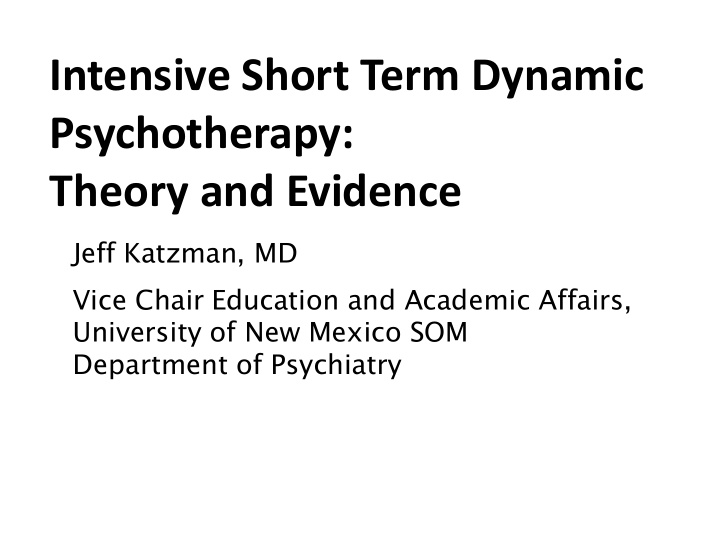



Intensive Short Term Dynamic Psychotherapy: Theory and Evidence Jeff Katzman, MD Vice Chair Education and Academic Affairs, University of New Mexico SOM Department of Psychiatry
Objectives 1. Become familiar with the research demonstrating both cost and clinical effectiveness of ISTDP in psychosomatic disorders. 2. Develop an understanding of the relationship between unconscious emotions, chronic pain, and psychological suffering 3. Identify the connection between repressed impulses and the patient's symptoms
Intensive Short Term Dynamic Psychotherapy – Why? Grounded in psychodynamic ideas It’s based in evidence Short Term Helpful for many patients
Pain and Unconscious Psychological Factors Pain is now understood as a complex problem, with emotional, cultural and social components Often the result of chronic anxiety and muscle tension Emotional pain that is avoided, is experienced as physical pain in the body
Pain and Unconscious Psychological Factors Many chronic pain patients repress their feelings and tend to do for others, are “selfless” and people pleasing Tend to push themselves and be perfectionistic Have trouble saying no, acknowledging anger, and setting boundaries
Pain and Unconscious Psychological Factors Highly related to trauma , stress, and emotional • dysregulation (Anda, et al, 2006) • Chronic stress increases sensitivity to pain (Aubert, 2008) • Many patients with chronic headaches have normal CT s and MRIs – emotional factors are significant • Often a “pain in the heart” becomes a “pain in the neck”
Cascade of Emotions Bond with Parents and Others Traumatic Event Psychic Pain Anger/Guilt over Anger Self/Destructive Defenses
Pain and Unconscious Psychological Factors Patients with headaches much more likely than controls to turn anger inward (Abbass, et al 2008) When exposed to anger provoking stimuli, headache suffers report less anger but more pain than controls (Abbass et al 2008)
ISTDP Evidence – Abbass, 2002 89 consecutively referred patients treated an average of 15 sessions Average age of 40; highly impaired 25% unemployed and on disability 33% hospitalized psych hospital/suicidal 46% on multiple psychiatric meds 83% treatment resistant (failed at 3 or more previous psychological therapies)
Abbass Results, 2002 71% stopped all meds 18 of 22 unemployed were back to work 17 of 18 off disability insurance Combined savings from prescriptions, disability, hospital and physician costs of $402,523 per year for three years following treatment
Effects of a Single Session Abbass, et al 2008 30 patients randomly assigned to ISTDP evaluation or standard intake 6 weeks no treatment and re-assess 7 out of 10 in treatment group went off meds 2 returned to work 33% required no further treatment No clinically significant findings in standard intake group
ISTDP - Evidence Abbass – 2009 Cochrane Review Meta Analysis of 23 Short Term Dynamic Psychotherapies Included 1431 patients Evaluated for general, somatic, anxiety, depressive symptom reduction Significantly greater improvement in treatment groups
Unexplained Symptoms in ER Abbass, et al 2010 Placed Psychologist in ER to evaluate patients who present with physical symptoms with no organic finding N= 77; average of 3.8 ISTDP sessions Focus on link between suppressed emotion and physical symptoms 69% reduction in repeat visits to hospital 80% reduction in panic attacks Massive cost savings to the system
ISTDP with Headache Abbass, Lovas, Purdy 2008 19 sessions average – 29 headache patients 23 patients taking 54 medications at start 7 out of work and on disability After treatment, 15 of 23 stopped all meds All 7 returned to work and off disability 34% drop in doctor visits, 85% decrease hospital use Maintained at 3 year follow up
ISTDP - Methodology Identify Presenting Problem Get Example of the Problem Identify Person in Example Encourage to experience feelings toward person Look for feeling, anxiety , or defense Facilitate experience of these feelings
Identify the Problem Ask for problem leading patient to seek help May be psychological issue or may be somatic complaint Get familiar with triggers and situations that seem to make it worse Get an example of the problem Identify a person in the example
Triangle of Person Current T ransference Past
Triangle of Conflict Anxiety Defense Impulse/Feeling
Basic Human Feelings Love, fear, anger, sadness/grief Components of a Feeling 1- cognitive label 2- physiological activation 3 - impulse/action tendency
Working with Defense Looking to help patient identify defense used, particularly pain Making link to avoidance of a feeling and emergence of a somatic experience extremely helpful Continue to work with patient through defense toward experience of feeling that is being avoided
Results of Working Through Decreased reliance on self destructive defenses Decreased Experience of Somatic Pain Increased capacity to experience affect Enhanced sense of well being Enhanced sense of authenticity Increased tolerance for ambivalence and complexity
Group Format John Sarno and Howard Schubiner pioneering Group treatment of back, neck, and headache pain, as well as fibromyalgia Psycho-education regarding the mind-body connection and relationship between conflicted emotions, anxiety and pain Encouraging participants to experience and express conflicted feelings Highly effective, with an average of 50% experiencing relief of all pain after 4 weeks Gains maintained at 6 month follow up
Recommend
More recommend